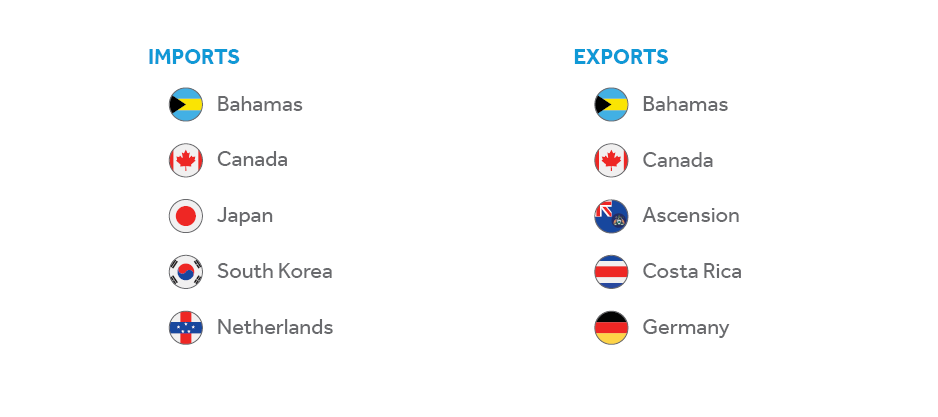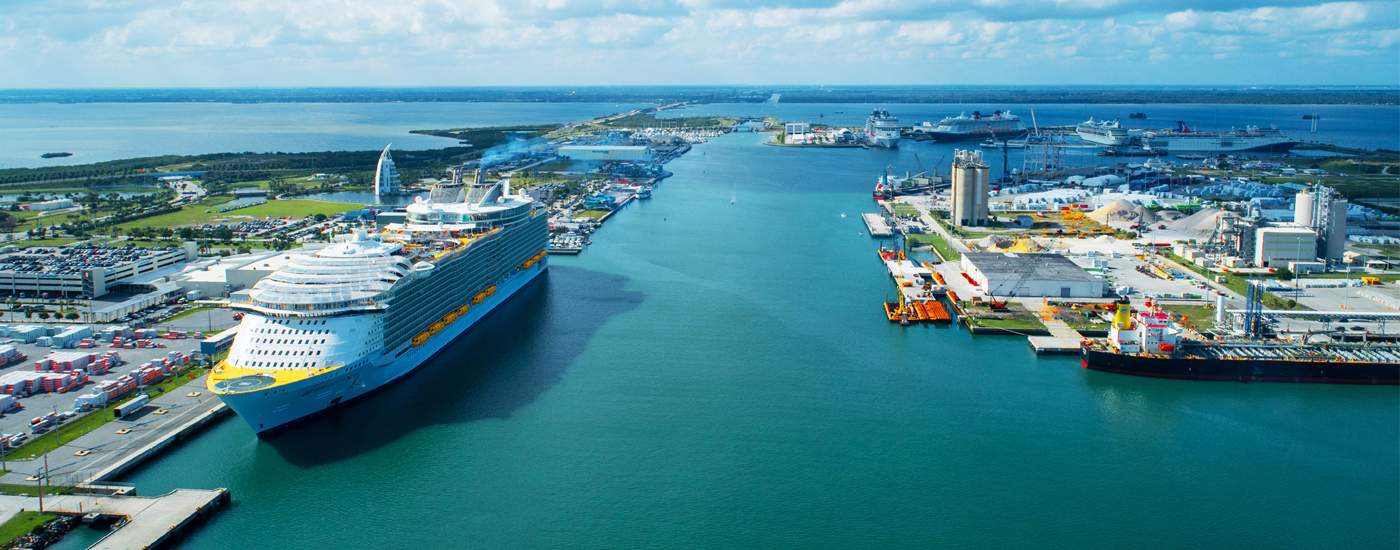Port Canaveral is a world-class, highly efficient deep-water seaport connecting commerce and consumers throughout the State of Florida and the southeastern United States. Located on the East Coast of Florida with direct access to/from the main Atlantic shipping lanes, the Port serves as a unique transportation hub linking sea, land, air, and space with the benefits of unrestricted air draft, 43-ft deep-water sea access, multipurpose berthing, and easy and efficient highway access.
The Port is a vital link for international commerce for the State of Florida and plays a continuing role in supplying critical commodities to Florida residents and businesses, as well as supporting maritime assets for the U.S. military, U.S. government, and commercial launch providers conducting launch operations from nearby NASA, Space Florida, and U.S. Space Force launch pads.
Approximately 75% of Port Canaveral’s total revenue earned from all business operations is derived from its cruise business. The Port is currently the second busiest cruise port in the world, handling over seven million multi-day cruise passenger movements in fiscal year 2023/24. The Port is homeport for several of the cruise industry’s newest, largest, and most sophisticated ships operated by the largest cruise brands in the world, and it was the first cruise port in North and South America capable of supporting LNG-powered cruise vessels.
Port Canaveral has grown its diversified cargo portfolio, handling a wide variety of dry and liquid bulk and breakbulk cargo, as well as heavy lift and project cargo, including high-value components for aerospace and military operations. The Port is the preferred port of entry to efficiently reach high-demand consumer markets in Central Florida with building and construction products, such as dimensional lumber, plywood, and other forest products; aggregates for roadway building; and transportation fuels from gasoline, diesel, and ethanol to jet fuel. Seaport Canaveral at Port Canaveral is the largest fuel terminal operator in the State of Florida.
Port Canaveral continues to invest in its infrastructure to expand its operational capabilities and increase capacity to add value to the Port’s business portfolio and maintain its competitive position for handling current and future business demands in an increasingly complex global economy. The Port’s five-year $560 million capital improvement plan is focused on harbor and landside infrastructure improvements, such as renovating cruise and cargo terminal facilities, and building and refurbishing multi-purpose deep-water berths to keep pace with demands and promote economic prosperity for the region.
Goals & Objectives
- Diversify the business portfolio with cargo terminal expansion and uplands improvement projects to accommodate more bulk and breakbulk cargo, and energy products storage and distribution (transportation fuels).
- Increase cargo handling capabilities and add capacity to accommodate bulk and breakbulk commodities, and increase heavy lift and project cargo for expanding commercial space operations.
- Improve berth capacities and capabilities to accommodate more frequent cargo and cruise vessel calls, larger ship sizes with higher passenger counts, and increased cargo volume/tonnage.
Current or Planned Investments
- REBUILD NORTH CARGO BERTH 4
Anticipated completion February 2025, which will add approximately 900 linear feet of multipurpose berth space as the current berth has been out of service since 2014. - BUILD TWO NEW CRUISE TERMINALS
Growing consumer demand for cruise has increased demand for homeporting cruise vessels at Port Canaveral. The Port’s Strategic Vision Plan identified the need for new and expanded cruise terminals in 2025 and 2031 respectively. - RENOVATE/REBUILD SOUTH CARGO BERTHS 3 AND 4 COMPREHENSIVE DREDGING PROJECT
Currently underway for berth box dredging at northside cargo berths to match the 43 ft depth of harbor. This will improve the Port’s capability to more efficiently accommodate cargo -laden deep draft vessels, especially tanker vessels loaded with jet fuel.
Accomplishments
- $110 million in total revenue for 2019 (highest in Port history)
- Completion of newly-built Cruise Terminal 3 complex in June 2020 to homeport Carnival Cruise Line’s Mardi Gras – the largest and newest class of ship and the first LNG powered cruise ship in North or South America..
- Carnival’s Mardi Gras arrived in June 2021 and began revenue sailings on July 31, 2021.
Hinterland
Port Canaveral’s hinterland includes the Central Florida region paralleling the I-4 corridor and the Central Florida I-95 corridor.
Cargo: Central and North Florida counties of Brevard, Polk, Indian River, Orange, Osceola, Seminole and Volusia.
Cruise: The U.S., Europe, the Bahamas and the Caribbean, Mexico, and Central and South America.
Trade Partners

Mission
Serve the district and region by facilitating waterborne commerce, creating employment, accommodating port- related business and industry, and otherwise positively impact the economic growth of the district.

